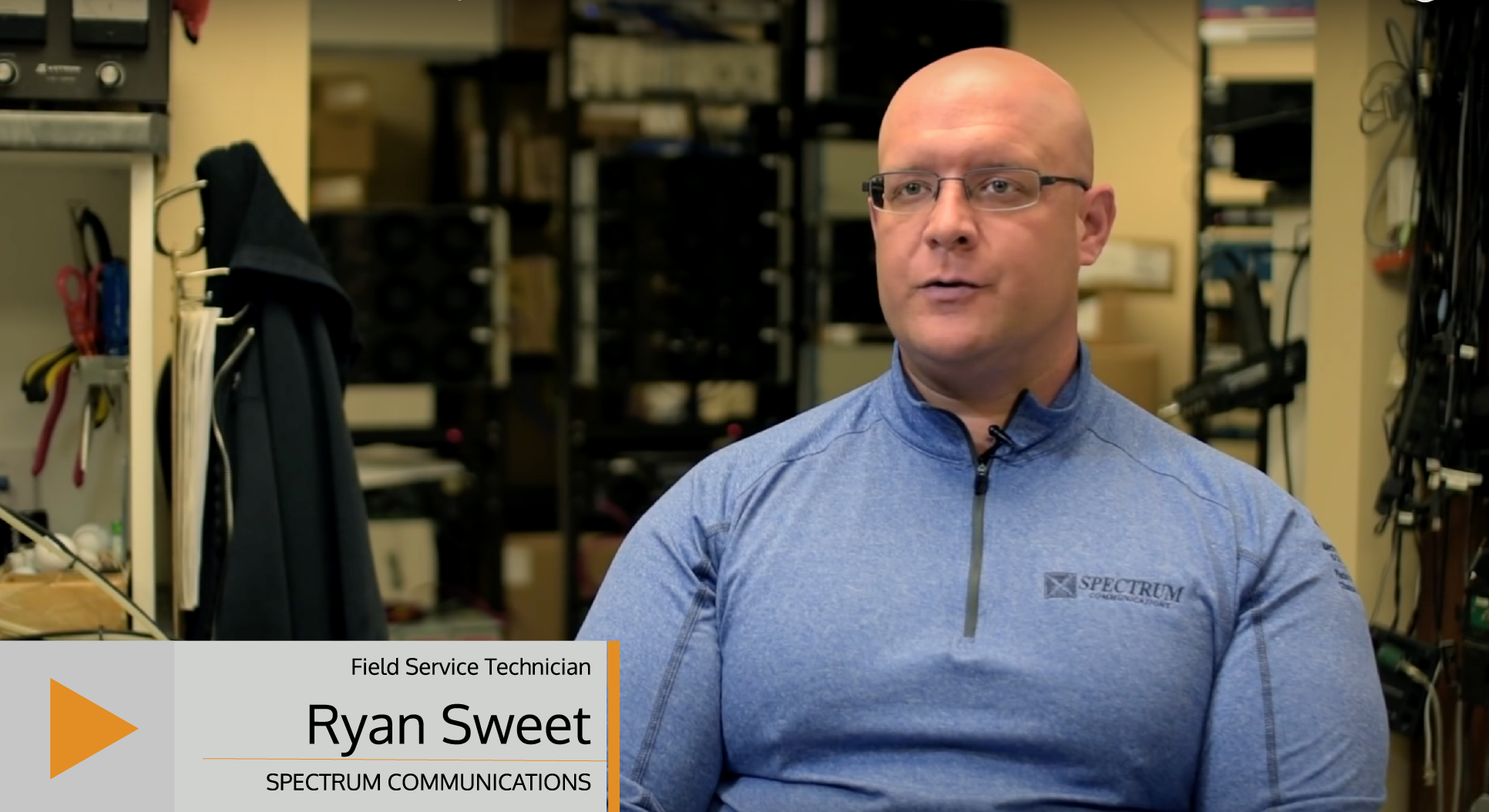
With over 30 years of experience working with Motorola Solutions’ two-way radios, Creative Communications’ Tim Taylor has a lot to say about radios. Last week, we set up a time to find out how he is using D3M to document his radio projects and hear his suggestions for the tool.
What do your daily activities entail?
I do a lot of in-building enhancement, as well as sales engineering for the MOTOTRBO platform for Creative Communications. I am involved with all MOTOTRBO sales from the initial meeting all the way through to the design plan and making sure everything goes well once the installation happens.
Who does your dealership do business with? what industries?
Public safety with state, local & federal government agencies for the P25 Radio Systems. I do all of the MOTOTRBO stuff and we have a Senior Engineer who does all of the P25 side. On the TRBO side, solar industries is very big, as well as resorts, hospitals, school districts, and utilities, we have a lot in those Industries.
Prior to D3M, what tools were you and your dealership using to design and document two-way radio networks?
Pretty much Vizio. I do all the end building coverage and I was using a program iBwave and it's more for modeling a building and placing antennas into it for inside coverage. You’re also able to import icons and so forth, so I was doing a little bit of the two-way radio design in the iBwave as well. We pretty much relied on Excel spreadsheets and Visio for any drawings that we had to have.
How does D3M compare to the tools you have used in the past?
I don't think there is any comparison. I think it is a much better tool. It is easier to build, once you have a basic template saved, you just duplicate it and change the values and frequencies and you’ve got your new project built already. Plus, the advantage of having everything stored on the server farm is that anybody can access it wherever they are as long as they have a network connection. From a drawing standpoint or getting a block diagram, or files, codeplugs or anything of that nature, we’re all connected to the internet and everybody has access to all those files wherever they are at. With Visio, you are very limited, you have to have your codeplugs in one location, your drawings in a separate location, and D3M pretty much just compiles everything into one.
How often are you using D3M and does it save you time?
Daily, at least. Usually when I come in, it's one of the first things I launch and I leave it open all day so I can reference it. Because I deal with so many customers every day, I like that I can go back and reference it.
D3M has saved me 50% in time. If I'm building a project today, one that simulates a project I did a month ago, I can duplicate it, go in and rename it, and just change my values and I've already got it built. But, to even build a new system from scratch, it is a fraction of the time. There's no question about it.
Are you using D3M throughout the life cycle of the radio sale?
Definitely using D3M throughout the life cycle. I typically start a new project once the sales person and I have gone out and met with the customer. I will design the system from that standpoint and it might be a month or two before we actually start the project. Then we move onto the subscriber side of it, so it is really important for us to have all that block diagram and information to go back and look at. You can actually modify and change the project depending on which way that project goes with the customer. We may have quoted a 4-site Linked Capacity Plus and in the end, they may only need 3, so you just go back and modify it, and D3M changes the equipment list and everything. From the fleetmap side of things, with all the subscribers, once we get a project and we have 200 radios to program, we use the D3M fleetmap side of things to add templates, unit IDs, radio serial numbers, and everything. D3M is referenced all the way through. If a customer sends a radio to the depot for repair, and it comes back needing reprogramming then we can reference that fleetmap for its serial number to know what goes back onto the radio. D3M is a very helpful tool.
Do you ever share D3M diagrams with customers?
More recently, we have been sharing the diagrams with customers. It is a lot simpler to print out the block diagram and normally on a proposal side, if I know what the customer is looking for, I can print off some examples of past projects. It gives them a visible block diagram, rather than just hearing about it from people. It works out well.
What do you like best about D3M?
A couple things - I like the ease of it. It doesn't get much easier to put together a block diagram together than with D3M. Another important thing is that everybody has connectivity to your files. If technician X goes in and makes a change, then that change stays with the project on the server. When I go in and look at that project, I see that change and don't have a different file. Everything stays up to date and I don't have a different version on my machine compared to somebody else’s machine. Everything is the same. From that aspect, it's nice that everybody can have access to customer files, wherever they are.
We have been using D3M for quite a while now, and we have customers that are upgrading systems that we installed a year ago. We can now go back in D3M and reference the system to see what they have and know what they need to expand.
What is the most significant benefit of using D3M?
Having the ability to share the work that you're doing. I can start building a project and the IT folks that need to see it can log in and see the same project. As well, being able to go back and reference projects and see what the customer has if they want to upgrade or add something down the road, it's a definite advantage being able to see everything globally on one screen to know what to add, or what not to add. With networking, it's so important to have the correct information in front of you. D3M makes it very simple to go to one location and view what the customer has and what they’re using.
What do you find most frustrating about D3M?
I haven't been frustrated with it at all. If anything, if I don't have a network connection and cannot connect to D3M to view the project details, that is what’s the most frustrating!
We've made recommendations [to D3M’s Development Team] in the past and it seems like one month later you see those recommendations brought out and implemented into the software. Right now, I can't think of a negative at this point.
I know you’re waiting for the rack diagram feature, but do you have other comments or suggestions of features that would help us improve D3M?
We have our own IT administrative staff here and if we need to build something, I always make recommendations to them. I go in and add my own user icons that I always use, but then if it is something that I know everybody can use, I'll make suggestions to our IT staff to add the icons that we need with the connections through the organization library.
Things always evolve and it's not to say we don't need anything right now, but the rack diagram would be very helpful. Even without them when you group equipment together, you know all that equipment is in the same location and probably in a rack. But, being able to see it in a rack is priceless sometimes. That will be a huge improvement.
What do you add to your diagrams to help your field technicians out?
I have been adding more details lately. I add the date of installation, who sold it, who installed it, who engineered it, contact information and I do that all within a text box. Another thing that I like to put on my diagrams is if there are any specific programming - what Channel 1 is, what Channel 2 is on the radio - I add that to a text box. The more information you add to a diagram, the better off you are.
Usually, when I group equipment together, the title at the top will be where that equipment is located. And, for warranty purposes, the customer always thinks it was yesterday when it was installed, but really it was 2 years ago. By adding this information, we know what has a 2 & 3-year warranty, and know if the equipment is under warranty or not.
Do you currently store project files on D3M?
I am, more and more recently. Originally, we were just using a spreadsheet to keep tracking of the fleet mapping information. Some of our early customers that we dealt with, all the information is stored on an excel spreadsheet, so I keep the customer codeplugs under the file and any spreadsheets that pertain to any of the equipment that has been sold to the customer. Before we were using D3M, if we had a customer with 40 radios with unique radio IDs, we would just open up a new spreadsheet to keep track of everything. Instead of that, we now just use D3M to store everything.
Would you recommend D3M to a friend in the industry?
Definitely, no question about it.
If you were to review D3M what score would you give it out of 10?
Overall, we’re very satisfied with it. I would give it a 9. It seems like every time we make suggestions, Chris and Bob are very good about staying in touch with us. If you make a suggestion, it just seems like it happens somehow. You don't see that in a lot of other industries. We're very happy with it!






